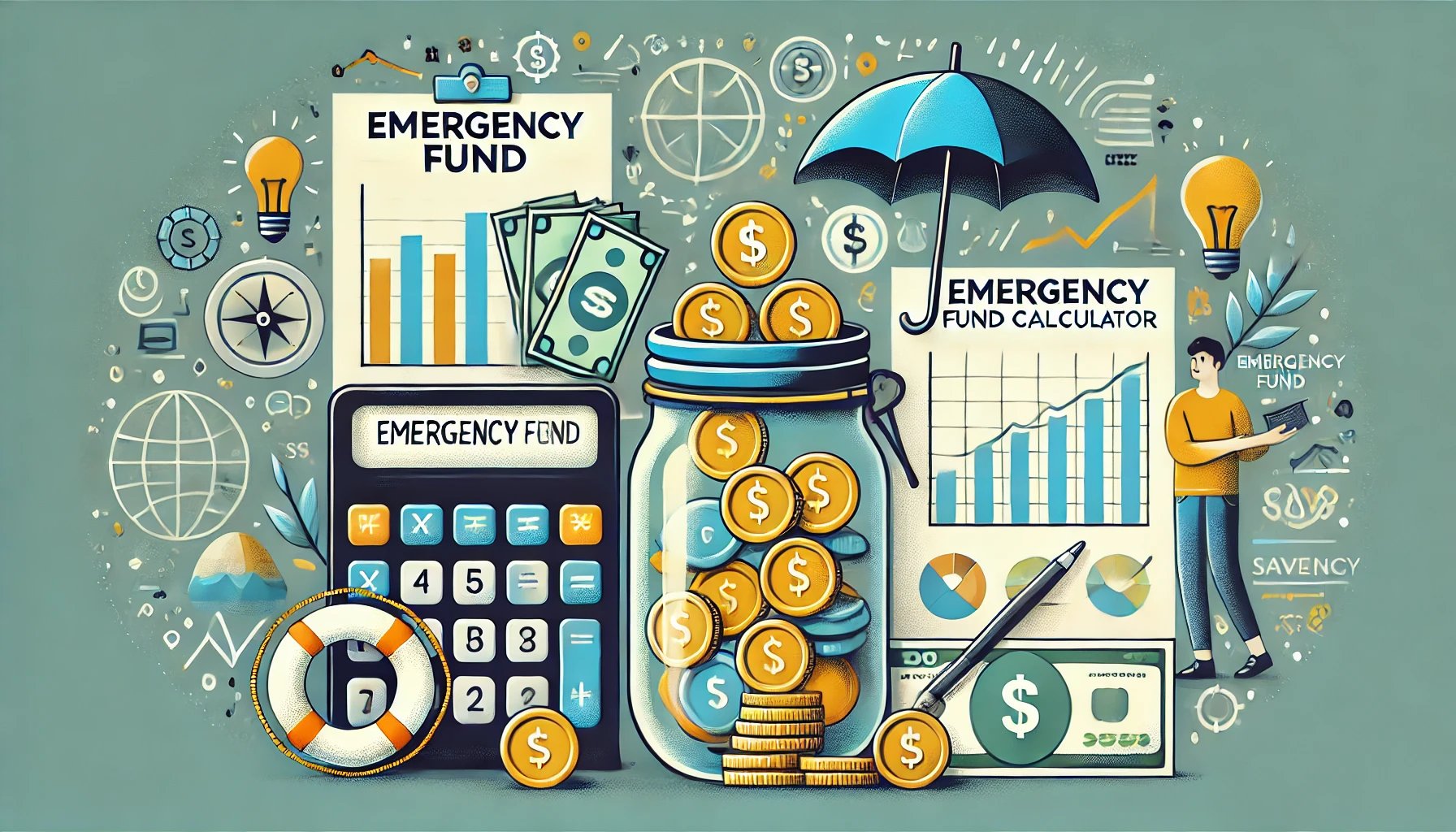Your cart is currently empty!
Emergency Fund Calculator

In an unpredictable world, financial stability is one of the most crucial aspects of a secure and stress-free life. Emergencies can come in many forms—job loss, medical bills, unexpected repairs—and they rarely give you any warning. That’s why an emergency fund is not just a recommendation; it’s an essential part of a sound financial plan. In this comprehensive guide, we’ll explore everything you need to know about building an emergency fund, how much you should save, and how using an Emergency Fund Calculator can make the process simpler and more precise.
What is an Emergency Fund?
An emergency fund is a dedicated pool of money set aside to cover unexpected expenses that life throws at you. Unlike your regular savings or investment accounts, an emergency fund is intended specifically for unforeseen situations—such as medical emergencies, car repairs, home maintenance, or even sudden job loss. The purpose is to have enough cash on hand to cover essential expenses without having to rely on loans or credit cards, which could put you into debt.
Why is an Emergency Fund Essential?
Financial experts often emphasize the importance of an emergency fund because it serves as a safety net for life’s surprises. Without an emergency fund, you may find yourself in a financially vulnerable position when unexpected expenses arise. Here are some key reasons why an emergency fund is essential:
Avoid Debt: Without an emergency fund, unexpected costs often have to be covered by credit cards or loans, which could lead to high-interest debt.
Peace of Mind: Knowing you have a financial cushion allows you to feel more secure and reduces stress during uncertain times.
Maintain Financial Stability: An emergency fund ensures you don’t need to dip into your retirement savings or sell investments at a loss to cover unexpected expenses.
Job Loss Protection: In the unfortunate event of losing your job, an emergency fund helps you manage daily expenses while you look for new employment.
How Much Should You Save in an Emergency Fund?
One of the most common questions people ask is, “How much should I save in my emergency fund?” While there isn’t a one-size-fits-all answer, the general rule of thumb is to have three to six months’ worth of essential living expenses in your emergency fund. This amount may vary based on several factors, including:
Income Stability: If you have a stable income or dual earners in the household, three months’ worth of expenses might suffice. If your income is variable or you are self-employed, you may want to aim for six to twelve months.
Family Size: Larger families may need a larger emergency fund to account for additional expenses, such as healthcare, groceries, and other essentials.
Debt Levels: If you have high-interest debt, you may want to focus on building a smaller emergency fund initially and use the rest of your disposable income to pay down debt.
Lifestyle and Obligations: If you have significant financial obligations, such as a mortgage, car loans, or dependents, you may want to save a larger emergency fund to cover these responsibilities.
Using an Emergency Fund Calculator can help you determine the exact amount you need based on your monthly expenses, financial obligations, and lifestyle preferences.
Steps to Building an Emergency Fund
Building an emergency fund may feel daunting, especially if you’re starting from scratch, but with a systematic approach, it becomes manageable. Here’s a step-by-step guide to help you build an emergency fund effectively.
1. Set a Savings Goal
The first step is to determine how much you need to save in your emergency fund. You can do this by calculating your essential monthly expenses (housing, utilities, food, insurance, transportation, etc.) and multiplying this figure by the number of months you want to cover (usually three to six). Alternatively, you can use an Emergency Fund Calculator to automate this process and provide a clearer picture of your savings goal.
2. Create a Budget
The next step is to evaluate your income and expenses by creating a budget. A budget will help you identify areas where you can cut back on non-essential spending and allocate those savings towards your emergency fund. Budgeting apps or even a simple spreadsheet can make the process easier and more efficient.
3. Automate Your Savings
Setting up automatic transfers from your checking account to a dedicated emergency fund account ensures that you consistently save money without having to think about it. Even a small amount, saved regularly, can accumulate over time. For instance, transferring $200 per month can result in $2,400 saved in just one year.
4. Start Small and Increase Over Time
If you’re unable to save a large amount initially, start small. Even saving $500 to $1,000 can provide some level of financial security and prevent you from taking on debt during minor emergencies. Once you’ve built this initial cushion, you can gradually increase your savings until you reach your target goal.
5. Keep Your Emergency Fund Separate
To avoid the temptation of spending your emergency savings, it’s important to keep the fund in a separate account. Ideally, use a high-yield savings account that offers a reasonable interest rate while providing easy access to your funds. Avoid tying up your emergency fund in investments that are difficult to liquidate, such as stocks or long-term fixed deposits.
6. Replenish After Use
If you need to use your emergency fund for an unforeseen expense, make it a priority to replenish the funds as soon as possible. The goal is to ensure that your safety net remains intact and ready to cover future emergencies.
Where to Keep Your Emergency Fund
The best place to keep an emergency fund is in a high-yield savings account or a money market account that offers easy access to your money. Some key factors to consider when choosing where to keep your emergency fund include:
Liquidity: Your emergency fund should be easily accessible when you need it. Avoid accounts that require a waiting period for withdrawals or that impose penalties for accessing funds.
Safety: Choose an account that is FDIC-insured to ensure that your money is protected.
Interest Rate: While the primary purpose of an emergency fund is safety, earning a reasonable interest rate helps your savings grow over time. High-yield savings accounts often offer better rates than traditional savings accounts.
Using an Emergency Fund Calculator
An Emergency Fund Calculator is a valuable tool that helps you estimate how much you need to save based on your specific financial situation. By inputting information such as your monthly expenses, financial obligations, and income stability, you can determine an appropriate target for your emergency fund. This calculator takes the guesswork out of the process and provides a clear goal to work towards.
Using the calculator involves a few simple steps:
Input Monthly Expenses: Enter your essential monthly expenses, such as rent/mortgage, utilities, groceries, transportation, and insurance.
Select Coverage Period: Choose the number of months you want your emergency fund to cover (typically three to six months).
View Your Results: The calculator will provide an estimate of the total amount you should aim to save in your emergency fund.
Having a specific target can help you stay motivated and track your progress more effectively.
Common Mistakes to Avoid When Building an Emergency Fund
While building an emergency fund is a straightforward process, there are some common mistakes that people make. Here are a few pitfalls to avoid:
Not Prioritizing Savings: It’s easy to delay saving for an emergency fund, especially if you’re focused on other financial goals. However, building an emergency fund should be a top priority, as it forms the foundation of financial security.
Dipping Into the Fund for Non-Emergencies: An emergency fund is meant for true emergencies, such as medical expenses, car repairs, or job loss. Avoid using the fund for vacations, shopping, or other discretionary expenses.
Setting Unrealistic Goals: It’s important to set an achievable savings goal based on your current financial situation. Starting with a smaller goal, such as $1,000, and building from there is more realistic than trying to save six months’ worth of expenses all at once.
Ignoring Inflation: Over time, the cost of living increases due to inflation. It’s important to periodically reassess your emergency fund to ensure that it still covers your essential expenses in today’s economic climate.
The Impact of Having an Emergency Fund on Financial Well-Being
An emergency fund plays a critical role in promoting financial well-being. Here are some of the benefits of having a well-funded emergency account:
Reduced Stress: Financial stress can take a toll on your mental and physical health. Knowing that you have a safety net provides peace of mind, reducing anxiety about unexpected expenses.
Improved Decision-Making: When you’re financially secure, you’re less likely to make decisions out of desperation. Having an emergency fund allows you to make rational choices, even during challenging times.
Avoidance of High-Interest Debt: Emergencies can be expensive, and without an emergency fund, people often resort to using credit cards or personal loans. These options come with high interest rates, which can lead to a debt spiral. An emergency fund helps you avoid this financial trap.
Flexibility: Having an emergency fund gives you the flexibility to deal with unexpected changes in your life. Whether it’s taking time off work to care for a loved one or dealing with an unforeseen medical issue, an emergency fund provides the financial cushion needed to manage life’s ups and downs.
Emergency Fund vs. Savings: Understanding the Difference
It’s essential to differentiate between your emergency fund and other types of savings. While both involve putting money aside for future use, they serve different purposes:
Emergency Fund: This is for unexpected, urgent expenses and should only be used in emergencies. It should be easily accessible, but not mixed with your everyday spending money.
Regular Savings: This includes money saved for planned future expenses, such as vacations, home improvements, or major purchases. These savings may be invested in accounts that offer higher returns, as they don’t need to be as easily accessible as an emergency fund.
Reaching Your Emergency Fund Goal
Building an emergency fund requires discipline, patience, and a clear strategy. Here are a few tips to help you reach your emergency fund goal:
Cut Back on Unnecessary Spending: Look for areas where you can cut back, such as dining out less frequently, reducing subscription services, or finding more affordable alternatives.
Use Windfalls Wisely: If you receive a windfall, such as a tax refund, bonus, or inheritance, consider allocating a portion towards your emergency fund. This can significantly accelerate your progress.
Track Your Progress: Regularly tracking your savings progress can help you stay motivated. Celebrate small milestones along the way, such as reaching your first $500 or $1,000.

Download The Financial Calculator App
Discover all the incredible features of our app designed to enhance your experience. From intuitive tools to unique services tailored for your needs, the app offers endless possibilities. Don’t miss out—click the link below to learn more and see how it can make a difference in your life today.
Conclusion: Financial Security Starts with an Emergency Fund
An emergency fund is a vital component of a well-rounded financial plan. It provides the peace of mind that comes from knowing you’re prepared for life’s unexpected challenges. By using an Emergency Fund Calculator, you can determine the right amount to save and take actionable steps toward building a strong financial safety net.
Remember, the journey to building an emergency fund starts with a single step. Whether you’re saving $20 or $200 a month, every contribution counts. Consistency and commitment are key to reaching your savings goal and ensuring that you have the security you need to weather any financial storm.

Mr. Rajeev Prakash
Rajeev is a well-known astrologer based in central India who has a deep understanding of both personal and mundane astrology. His team has been closely monitoring the movements of various global financial markets, including equities, precious metals, currency pairs, yields, and treasury bonds.
